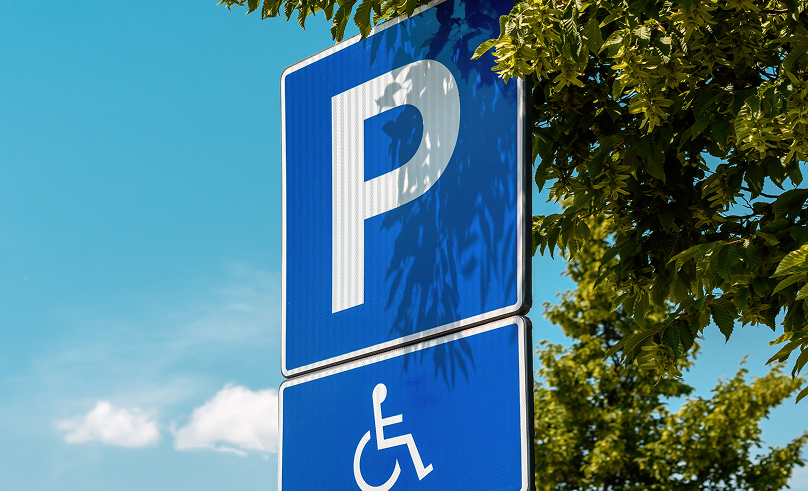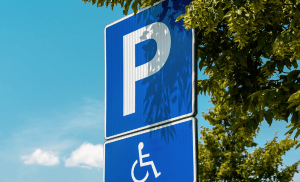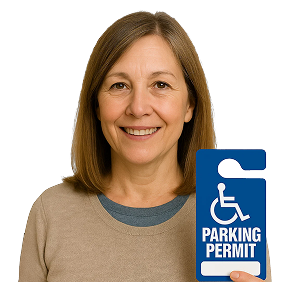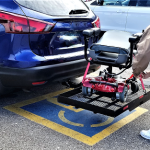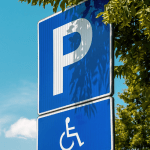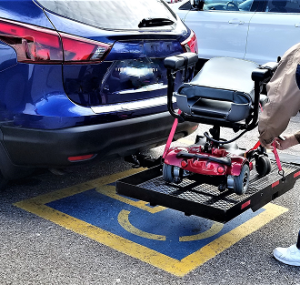If you’re wondering whether your medical condition qualifies for a handicap placard, you’re not alone. Millions of Americans live with disabilities that affect their mobility, yet many are unaware they may be eligible for accessible parking permits. Whether you’re dealing with a chronic condition like arthritis, recovering from surgery, or managing an invisible disability, understanding which medical conditions qualify for a handicap placard can significantly improve your quality of life.
A handicap placard provides more than just convenient parking. It offers independence, energy conservation, and reduced physical strain for those who need it most. The good news is that qualifying conditions extend far beyond what many people realize, including temporary disabilities, chronic pain conditions, and various invisible illnesses.
In this comprehensive guide, we’ll explore the medical conditions that qualify for handicap placards, explain the difference between permanent and temporary permits, and help you understand the application process.
Types of Disability Parking Permits Available
Understanding the different types of handicap placards available is crucial for determining which option best fits your situation. Most states offer several types of disability parking permits, each designed for specific circumstances and duration needs.
Permanent Placards are typically blue in color and designed for individuals with long-term or permanent disabilities. These placards are usually renewable every 4 years and don’t require repeated medical certification in most states once initially approved.
Temporary Placards are usually red in color and issued for short-term disabilities or recovery periods. These placards expire in 6 months or less and are perfect for post-surgical recovery, broken bones, or temporary mobility limitations.
Organizational Placards are available for institutions, retirement communities, or organizations that regularly transport people with disabilities. These are typically green in color and valid for several years.
License Plates vs. Placards: While both serve the same purpose, license plates are permanently attached to a specific vehicle, whereas placards can be moved between vehicles when the disabled person is present.
The benefits of having a disability parking permit extend beyond just closer parking spaces. Those with disabled parking placards may park in any spot designated for persons with disabilities and be exempt from local and state government parking meters. Many jurisdictions also allow extended parking time in metered spaces.
Basic Requirements for Handicap Placard Qualification
Before diving into specific medical conditions, it’s important to understand the general eligibility requirements that apply across most states. Placard and plate eligibility is based on a medical condition that meets the legal definition of a disability, which typically includes several key criteria.
The most common baseline requirements include:
- Inability to walk 200 feet without stopping to rest due to a medical condition
- Use of mobility aids such as wheelchairs, walkers, canes, crutches, or other assistive devices
- Severe limitation in walking ability due to various medical conditions
- Requirement for assistance from another person to walk safely
A licensed physician, physician assistant, or registered nurse practitioner must determine if you qualify for disabled parking. The healthcare provider must complete medical certification forms that verify your condition and its impact on your mobility.
It’s worth noting that you do not need a Medical Provider’s Certification of Disability if you have lost a lower extremity or both hands and appear in person at a DMV office in some states, as the disability is visually apparent.
State requirements can vary, so it’s essential to check your specific state’s criteria. However, the Americans with Disabilities Act (ADA) provides federal guidelines that ensure consistency across most jurisdictions.
Medical Conditions That Qualify for Permanent Handicap Placards
Permanent handicap placards are designed for individuals with long-term or permanent medical conditions that significantly impact mobility. These conditions span multiple medical categories and include both visible and invisible disabilities.
Mobility and Orthopedic Conditions
Orthopedic conditions affecting the musculoskeletal system are among the most recognized qualifying conditions for handicap placards. Severe arthritis, classified as Class III or Class IV functional arthritis according to the standards set by the American College of Rheumatology, qualifies for permanent parking permits.
Arthritis in its severe forms can significantly limit mobility and cause chronic pain. When arthritis progresses to advanced stages, simple activities like walking from a distant parking space can become extremely painful and exhausting.
Amputations or loss of limb function clearly qualify for handicap placards, as they directly impact a person’s ability to walk normally or for extended distances. Individuals who have lost one or more limbs or permanently lost the use of one or more limbs are eligible for disability parking permits.
Spinal conditions and paralysis, including spinal cord injuries, severe spinal stenosis, and conditions causing partial or complete paralysis, qualify for permanent placards. These conditions often require the use of wheelchairs or significantly limit walking ability.
Neurological disorders such as Multiple Sclerosis, Parkinson’s disease, and stroke survivors frequently qualify due to their progressive nature and impact on mobility, balance, and coordination. Severe limitations in walking ability due to neurological conditions are recognized as qualifying criteria.
Muscular dystrophy and neuromuscular conditions progressively affect muscle strength and coordination, making extended walking difficult or impossible.
Cardiovascular Conditions
Heart conditions can significantly impact a person’s ability to walk distances without experiencing dangerous symptoms. Cardiac conditions classified in severity as Class III or Class IV according to the standards set by the American Heart Association qualify for handicap placards.
Heart failure in advanced stages severely limits physical activity tolerance. Individuals with Class III heart failure experience marked limitation in activity, while Class IV indicates symptoms at rest.
Coronary artery disease with severe limitations can cause chest pain, shortness of breath, and fatigue with minimal exertion, making walking from distant parking spaces potentially dangerous.
Individuals with cardiovascular conditions that cause severe shortness of breath at rest or with minimal exertion may qualify for a permit. The inability to walk without experiencing cardiac symptoms is a clear indicator of eligibility.
Dependence on supplemental oxygen due to cardiovascular disease automatically qualifies individuals for disability parking permits, as oxygen equipment makes mobility more challenging.
Respiratory and Pulmonary Conditions
Lung diseases can severely limit a person’s ability to walk distances without becoming breathless or experiencing dangerous drops in oxygen levels. Restriction by lung disease to such an extent that the person’s forced (respiratory) expiratory volume for one second, when measured by spirometry, is less than 1 liter or the arterial oxygen tension is less than 60 mm/hg on room air at rest, qualifies for handicap placards.
COPD (Chronic Obstructive Pulmonary Disease) significantly limits breathing capacity and exercise tolerance. Even short walks can cause severe shortness of breath in individuals with advanced COPD.
Severe asthma that limits daily activities and requires frequent use of rescue medications may qualify, especially when it significantly impacts walking ability.
Pulmonary fibrosis causes scarring of lung tissue, leading to progressive breathing difficulties and reduced oxygen levels during physical activity.
Cystic fibrosis affects both the respiratory and digestive systems, often requiring individuals to conserve energy for essential daily activities.
Individuals who use portable oxygen automatically qualify for handicap placards, as oxygen equipment adds complexity to mobility and requires shorter walking distances.
Visual Impairments
Vision loss can significantly impact safe mobility, especially in unfamiliar environments like parking lots. Visual acuity of 20/200 or less in the better eye with correcting lenses or visual acuity of more than 20/200 but with a limited field of vision in which the widest diameter of the visual field subtends an angle of 20 degrees or less qualifies for handicap placards.
Legal blindness is defined as visual acuity of 20/200 or worse with the best possible correction. This level of vision impairment is considered legally blind and can make it difficult or impossible to drive safely without special accommodations.
Severe visual field restrictions can be just as limiting as reduced visual acuity, making navigation through parking lots dangerous and requiring closer parking spaces for safety.
Invisible Disabilities and Chronic Conditions
One of the most misunderstood categories of qualifying conditions involves invisible disabilities, conditions that significantly impact mobility but aren’t immediately apparent to observers. In fact, 96% of chronic medical conditions are invisible, yet they can be just as debilitating as visible disabilities.
Fibromyalgia is a chronic condition characterized by widespread pain, fatigue, and tender points throughout the body. Individuals with fibromyalgia often experience heightened sensitivity to pain, making routine activities like walking, standing, or carrying heavy objects extremely challenging. People who suffer from fibromyalgia tend to qualify for disabled parking under the official qualifying condition of an inability to walk 200 feet without needing to stop to rest.
Chronic fatigue syndrome causes extreme exhaustion that doesn’t improve with rest and can make walking even short distances overwhelming.
Lupus and autoimmune disorders can cause joint pain, muscle weakness, and extreme fatigue, significantly impacting mobility on unpredictable schedules.
Chronic pain conditions, including Complex Regional Pain Syndrome, severe neuropathy, and other persistent pain disorders, can make walking distances extremely difficult.
Heart disease and circulatory disorders causing chronic fatigue and shortness of breath, neurological disorders like epilepsy and severe migraines, and balance disorders such as Meniere’s disease all qualify as invisible disabilities for handicap parking permits.
Conditions That Qualify for Temporary Handicap Placards
Temporary handicap placards serve individuals with short-term mobility limitations, typically lasting from a few weeks to six months. These permits are essential for people recovering from medical procedures or experiencing temporary health setbacks.
Post-Surgical Recovery
Recovery from surgery often involves mobility restrictions that make walking distances dangerous or impossible. To qualify for a temporary handicap placard after surgery, you generally need medical documentation from a healthcare provider certifying your condition and confirming how it impacts your mobility.
Orthopedic surgeries, including knee replacements, hip replacements, ankle reconstructions, and spinal surgeries, typically require extended recovery periods with limited mobility. Patients often need mobility aids and cannot walk normal distances safely.
Cardiac procedures may require activity restrictions to prevent complications during healing. Heart surgery patients often have strict limitations on physical exertion for several months.
Abdominal surgeries can affect core stability and make walking uncomfortable or dangerous during the initial recovery period.
The recovery timeline varies significantly depending on the procedure, but temporary placards are typically valid for a limited time, often up to six months, depending on local regulations.
Injury-Related Conditions
Temporary injuries that significantly impact walking ability clearly qualify for temporary handicap placards. Inability to walk without needing to stop or rest, due to a temporary mobility condition like a broken or injured foot, back or spine injuries, or limited mobility while recovering from surgery all qualify.
Broken bones in the legs, feet, pelvis, or spine can make walking impossible or require the use of mobility aids like crutches or wheelchairs.
Severe sprains and soft tissue injuries may require extended periods of limited mobility while tissues heal.
Back injuries can cause severe pain and instability, making walking distances unsafe even if the injury will eventually heal.
Sports injuries affecting major joints or requiring surgical repair often necessitate temporary mobility restrictions.
Pregnancy-Related Conditions
Pregnancy complications can significantly impact mobility and qualify for temporary handicap placards. If your pregnancy has prevented you from moving about normally, then yes, most doctors will happily sign off on your approval for a temporary placard.
High-risk pregnancies with mobility restrictions prescribed by healthcare providers qualify for temporary permits.
Bed rest prescriptions clearly indicate the need for limited mobility and closer parking access for essential appointments.
Pregnancy complications such as severe edema, pelvic pain, or balance issues can make walking distances dangerous for both mother and baby.
Postpartum recovery following complicated deliveries or cesarean sections may require temporary mobility assistance.
Acute Medical Episodes
Sudden health changes can temporarily impact mobility and qualify for short-term parking permits.
Recent stroke survivors often experience temporary paralysis, weakness, or balance issues that improve with rehabilitation.
Severe illness requiring recovery periods, such as pneumonia, severe infections, or acute cardiac events, may necessitate temporary activity restrictions.
Chemotherapy side effects including neuropathy, weakness, and nausea can significantly impact mobility during treatment periods.
Temporary vision loss from surgeries, medications, or medical conditions can make parking lot navigation dangerous.
How Qualification Requirements Vary by State
While the Americans with Disabilities Act provides federal guidelines, individual states maintain their own specific requirements and procedures for handicap placards. Understanding these variations is crucial for successful applications.
The law requires a statement from a qualified medical practitioner recertifying your qualification for wheelchair symbol plates or placards every three years in some states, while others have different renewal requirements.
Documentation requirements vary significantly between states. Some states accept nurse practitioner certifications, while others require physician signatures. A licensed physician, surgeon, chiropractor, optometrist, physician assistant, nurse practitioner, or certified nurse midwife that has knowledge of the disease and/or disability must complete and sign the Medical Provider’s Certification in California, while other states may have more restrictive provider requirements.
Renewal periods differ substantially. Blue placards for permanent disabilities are renewable every 4 years in Texas, but other states may require more frequent renewals or different timeframes.
Special provisions include veteran benefits in many states. Texans with disabled veteran license plates wishing to use disabled parking spaces may apply for a disabled parking placard with specific military documentation requirements.
Interstate recognition is generally provided under federal law, but parking rules may vary. If you are visiting Texas from another state or country, your valid disabled parking placard and plates will be honored, provided the placard/plate is valid.
How to Apply for a Handicap Placard with Qualifying Conditions
The application process for handicap placards involves several steps, but understanding the requirements can make the process straightforward and efficient.
Required Documentation
Medical certification forms are the cornerstone of any handicap placard application. A healthcare provider must certify your condition and confirm how it impacts your mobility. The certification must be completed by qualified medical professionals and include specific information about your condition and its functional limitations.
Healthcare provider qualifications vary by state but typically include physicians, physician assistants, nurse practitioners, and in some cases, chiropractors, optometrists, or other specialists relevant to your condition.
Personal identification requirements usually include a valid driver’s license or state ID, proof of residency, and sometimes Social Security documentation.
Medical documentation supporting your condition may be required, including recent medical records, test results, or specialist evaluations that demonstrate the severity and impact of your condition.
Application Methods
Online applications are increasingly available in many states, offering convenience and faster processing times. ParkingMD provides online evaluations that can be completed from the comfort of your home, connecting you with licensed physicians who can certify your eligibility.
In-person DMV visits remain the traditional method in many states, though they often involve longer wait times and scheduling challenges.
Mail-in applications provide an alternative for those who cannot visit DMV offices in person, though processing times may be longer.
Third-party services like ParkingMD streamline the entire process by providing medical evaluations, form completion assistance, and guidance through state-specific requirements.
Processing Times and Fees
Typical processing timeframes vary significantly by state and application method. After your evaluation, you’ll typically receive your signed medical certification within 24 to 48 hours when using services like ParkingMD, followed by DMV processing that can range from same-day issuance to several weeks for mail-in applications.
Fee structures differ by state, with many offering free placards while others charge modest fees for processing or replacement.
Rush processing options may be available in some states for urgent medical situations or immediate post-surgical needs.
Renewal procedures typically require less documentation than initial applications, though medical recertification may be needed after several years.
Professional Assistance for Handicap Placard Applications
Navigating the handicap placard application process can be complex, especially when dealing with health challenges. Professional assistance can streamline the process and ensure successful applications. The benefits of using online medical evaluation services include:
Convenience and accessibility – Complete your evaluation from home without the physical strain of DMV visits or doctor’s office waiting rooms.
Expert guidance – Licensed physicians familiar with disability parking requirements can properly assess your condition and complete necessary documentation.
Time efficiency – After your evaluation, you’ll typically receive your signed medical certification within 24 to 48 hours, significantly faster than traditional appointment scheduling.
State-specific expertise – Professional services understand the varying requirements across different states and ensure your application meets all local criteria.
Comprehensive support – From initial evaluation through final DMV submission, professional services guide you through each step of the process.
The online evaluation process is straightforward: complete a medical questionnaire, schedule a consultation with a licensed physician, discuss your condition and mobility limitations, and receive your medical certification if you qualify. This approach is particularly valuable for individuals whose conditions make traveling to appointments difficult or painful.
Conclusion
Understanding which medical conditions qualify for a handicap placard is the first step toward improving your mobility and independence. From permanent conditions like severe arthritis and heart disease to temporary situations like post-surgical recovery, a wide range of medical circumstances can qualify you for accessible parking privileges.
The key qualifying factors consistently revolve around mobility limitations, whether you can’t walk 200 feet without stopping to rest, require mobility aids, or have conditions that make extended walking dangerous or impossible. Remember that many qualifying conditions are invisible, and you shouldn’t hesitate to pursue a handicap placard if your condition legitimately impacts your mobility.
If you believe your medical condition may qualify for a handicap placard, don’t wait to explore your options. Consult with your healthcare provider or consider an online evaluation to determine your eligibility. The improved accessibility and independence that comes with a handicap placard can significantly enhance your quality of life and ability to participate fully in daily activities.
Frequently Asked Questions
Can family members use the placard?
A parking placard or plate is ONLY valid when being used by the person with the disability or someone who is driving the person with the disability. Family members cannot use the placard when the disabled person is not present.
What if I don’t look disabled?
Just because someone looks fine doesn’t mean they don’t experience daily struggles with chronic pain, fatigue, or other invisible symptoms. Many qualifying conditions are not visually apparent.
How often do I need medical recertification?
This varies by state and permit type. Temporary permits typically require new medical certification for each renewal, while permanent permits may not require recertification for several years.
Can I use my placard in other states?
Yes, Pennsylvania’s Persons with Disabilities placards are accepted in all 50 states, and this reciprocity generally applies to all state-issued handicap placards under federal ADA requirements.
What happens if I lose my placard?
If your placard is lost or stolen, you can replace it by presenting a copy of the form that you originally submitted to your local county tax assessor-collector office, though procedures vary by state.

